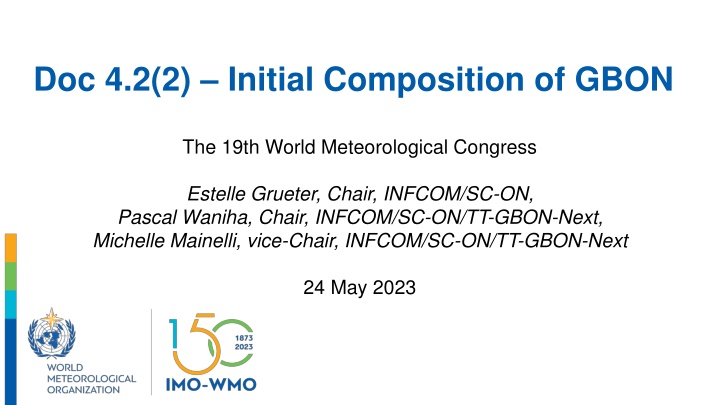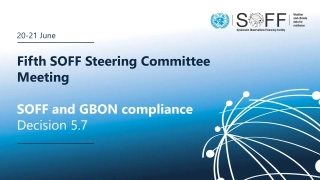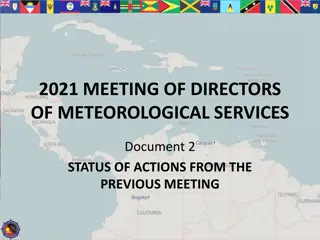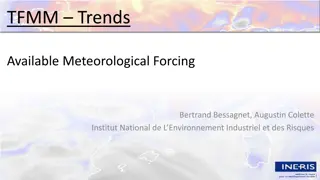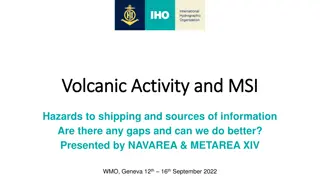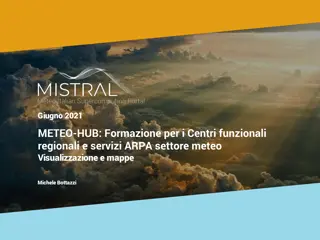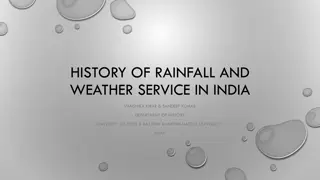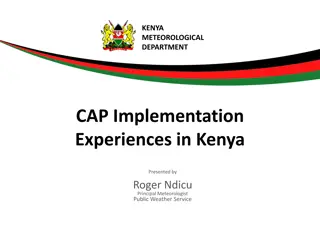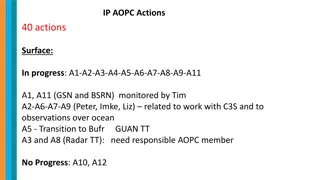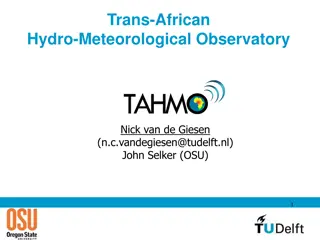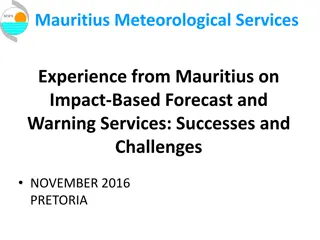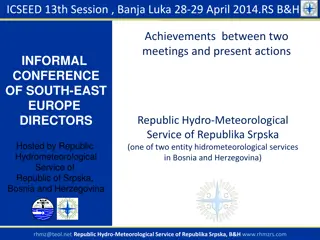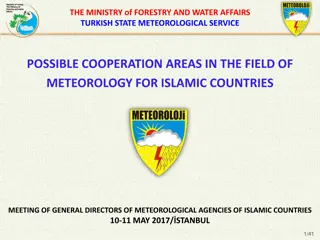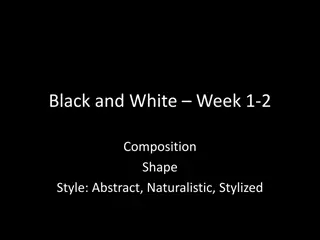Initial Composition and Requirements of GBON for Effective Meteorological Monitoring
The 19th World Meteorological Congress established the Global Basic Observing Network (GBON) to enhance meteorological monitoring worldwide. The GBON includes specific resolutions, guidelines, requirements, and compliance criteria for surface land stations, upper air stations, aircraft data, and remote sensing profiler observations. Compliance with GBON regulations outlined in the Manual on the WMO Integrated Global Observing System is essential for effective data exchange and monitoring.
Download Presentation

Please find below an Image/Link to download the presentation.
The content on the website is provided AS IS for your information and personal use only. It may not be sold, licensed, or shared on other websites without obtaining consent from the author.If you encounter any issues during the download, it is possible that the publisher has removed the file from their server.
You are allowed to download the files provided on this website for personal or commercial use, subject to the condition that they are used lawfully. All files are the property of their respective owners.
The content on the website is provided AS IS for your information and personal use only. It may not be sold, licensed, or shared on other websites without obtaining consent from the author.
E N D
Presentation Transcript
Doc 4.2(2) Initial Composition of GBON The 19th World Meteorological Congress Estelle Grueter, Chair, INFCOM/SC-ON, Pascal Waniha, Chair, INFCOM/SC-ON/TT-GBON-Next, Michelle Mainelli, vice-Chair, INFCOM/SC-ON/TT-GBON-Next 24 May 2023
Outline 1.Resolution 2 (Cg-Ext(2021)) taking effect from 1 January 2023 2.Resolution 20 (EC-76) - Guide to GBON 3.GBON Requirements & Compliance 4.GBON Global Gap Analysis 5.Process for the designation of GBON stations 6.Draft Resolution 4.2(2)/1 (Cg-19) Initial composition of GBON
Resolution 2 (Cg-Ext(2021)) Amendments to the Technical Regulations related to the establishment of GBON Cg-Ext requested development of technical guidelines, processes and procedures, etc., needed to ensure an efficient implementation of GBON and to prepare for the effective performance and compliance monitoring of GBON, GBON regulatory provisions included in the Manual on the WMO Integrated Global Observing System (WMO-No. 1160), section 3.2.2 Global Basic Observing Network
Resolution 20 (EC-76) - Guide to GBON (developed by TT-GBON, supported by the Secretariat) A new chapter in the Guide to WIGOS, WMO-No. 1165 Summary of requirements Process for the designation of GBON stations Guidance on national GBON gap analysis and contribution plans GBON compliance criteria Reporting of hourly observations Guidance on using OSCAR/Surface in relation to GBON Will be published in all WMO languages
GBON requirements summary (mandatory in bold) Horizontal Resolution 200km 100kma Vertical Resolution n/a Observing cycle 1h Variables Other requirements Surface land stations SLP, T, U, Wind, precip. (hourly cumul), snow depth T, U, wind Exchanged in real time through WIS2 Upper air stations operated from land 500km 200kma 100m 2/24h Up to 30 hPa, exchanged in real time through WIS-2 1000kmb Subset of upper air stations up to 10hPa Surface marine stations in EEZs Upper air stations operated in EEZs Aircraft data 100m 24h T, U, wind Up to 10hPa, Exchanged in real time through WIS2 Exchanged in real time through WIS2 Up to 30 hPa, exchanged in real time through WIS2 Data exchange per licensing agreement 500km n/a 1h SLP, SST 1000km 100m 2/24h T, U, wind 100km at flight level 300m profiles for 1h T, U, wind Remote sensing profiler observations Where available 100m 1h T, U, wind n/a a: High density requirement is mandatory for data exchange where capability exists b: Requirement is mandatory for data exchange where capability exists
GBON compliance criteria GBON REGULATIONS The full set of the GBON provisions is specified in the Manual on the WMO Integrated Global Observing System (WMO-No. 1160), section 3.2.2. COMPLIANCE CRITERIA Included in the Guide to GBON The definition of GBON compliance criteria includes the aggregation of metrics, spatially and temporally, for surface and upper-air stations/networks (coverage, uptime, data delivery) and will accommodate mobile or mixed networks as needed.
GBON compliance criteria (by Station) Low complexity approach adopted Designated GBON stations assumed to provide required horizontal spacing Station registered in OSCAR/Surface with GBON affiliation Availability: Use monthly monitoring of GBON availability statistics per station: Number of monthly pressure reports / (days per month * 24) > 80% Number of monthly temp profile reports (to 30hPa) / (days per month * 2) > 80% Timeliness: Use monthly NWP received statistics per station Number of late pressure reports / (days per month * 24) < 5% Number of late temp profile reports (to 30 hPa) / (days per month * 2) < 5% Quality: Use monthly GBON NWP rejection statistics per station Number of rejected pressure reports / (days per month * 24) < 5% Number of rejected temp profile reports (to 30 hPa) / (days per month * 2) < 5%
GBON Compliance Criteria (by Member) Monthly assessment computed on quarterly basis Each Member assessed against the quarterly reports on annual basis All nominated GBON stations for initial seeding are recorded in OSCAR/Surface and affiliated to GBON Number of compliant GBON surface-land stations >= Number of required surface-land stations from the GBON Global Gap Analysis Number of compliant GBON Upper Air Stations >= Number of required Upper Air stations from the GBON Global Gap Analysis
Global GBON Gap Analysis Based on 1 January 2022 baseline & status of actively reporting stations (green or orange in WDQMS) Reports > 30% of required obs. for more than 60% of the days Computed against GBON requirements Gives estimate of number of missing surface- and upper air stations (required minus baseline) These are only estimates / first guess only Members know their capabilities in detail
Global GBON Gap Analysis January 2022 Surface observations Upper air observations Gap in SIDS and LDCs (standard density): 596 surface stations; existing network (actively reporting) delivers roughly 9% of required number of observations; Gap in SIDS and LDCs (standard density): 139 upper air stations; existing existing network delivers roughly 8% of required number of observations;
Circular to Members on Implementation of GBON Letter issued on 15 August 2022 Letter had 4 annexes (1: Reference to useful material, 2: Required actions by Members for initial composition of GBON, 3: Criterial for initial seeding of GBON, 4: Global gap analysis for the Country Members were invited to Conduct national gap analysis using TT-GBON guidance and template Set national targets and develop national contribution plan per TT-GBON guidance Nominate NFP for OSCAR/Surface Consider proposals of the Secretariat on initial seeding of GBON stations Confirm (do nothing) or object (un-assign designation to GBON) Designate additional GBON stations using OSCAR/Surface See also website with above guidance
Nominate WIGOS,OSCAR/Surf ace and WDQMS National Focal Points if not already done Define national GBON targets based on the GBON Global Gap analysis (see guidance in GBON Guide and template) Respond to incidents raised by Regional WIGOS Centre Develop GBON National Contribution Plan (see guidance in GBON Guide) based on national gap analysis Monitor compliance of GBON stations with GBON requirements using WDQMS web tool Practical steps for designating GBON stations Identify existing operational stations to be committed to GBON (see WDQMS) Check status of designated GBON stations using GBON web tool Consider upgrading existing stations to meet GBON requirements (19thCongress decides on initial composition of GBON; then INFCOM at each of its Sessions) Consider arrangement with national partners for their long-term commitment of GBON stations If applicable, Article 9 of the Convention might be invoked for claiming exemption to meet GBON Requirement (see GBON Guide 4.5) Declare GBON stations in OSCAR/Surface and assign them to GBON network (pending approval mode) Consider installing new observing stations to be committed to GBON
Doc.4.2(2) - Initial GBON Composition Through Draft Resolution 4.2(2)/1, Congress is invited to: Adopt the initial composition of GBON See INF 4.2(2) for the complete list of proposed land surface and upper air observing stations Annex 2 to draft Resolution 4.2(2)/1 includes changes that Members may wish to propose from the list in INF 4.2(2) Give authority to INFCOM to make any subsequent decisions related to maintaining and updating of the GBON composition in accordance with the Manual on the WMO Integrated Global Observing System (WMO-No. 1160)
Doc.4.2(2) P/INFCOM changes in draft3 Vast majority of Members are in compliance with the required number of stations for the standard density LDCs & SIDS will benefit from SOFF support NWP models increasingly relying on high resolution data WMO-No. 1160 provisions 3.2.2.8 and 3.2.2.13 require that Members should commit GBON stations at high density, i.e. 100 km for surface land stations and 200 km for Upper Air Stations WMO-No. 1160 provisions 3.2.2.5 and 3.2.2.9 require that Members shall make observations where capability exists at such density available internationally Members urged to pay particular attention to compliance with the GBON high density requirements for surface land stations (100 km) and upper air stations (200 km) where capability exists, and make sure that there will be no degradation of the international reporting of such station data according to the GBON January 2022 baseline
Exceptionally claiming exemption to meeting GBON requirements Some Members may face real challenges to meeting the GBON requirements in some instances e.g., large remote geographic areas; performing 2 soundings a day or to report hourly observations of the manned stations pending their automation, etc. Members may exceptionally claim exemption to meeting GBON requirements by invoking Article 9 of WMO Convention Members wishing to claim exemption should write to the WMO Secretary General and indicate: The reasons for claiming exemption, e.g., for network density in some parts of their territory, or for a sub-set of their observing stations not being able to report at the required frequency The requested duration of exemption A plan for improving the situation in the future Members wishing to claim exemption were invited to write to Secretary General before 19th Congress (May 2023) or the start of effective compliance monitoring of GBON (Q3/2023) Template of request available from the Secretariat upon request (gbon@wmo.int ) INFCOM ad hoc Committee will review cases & advise whether exemption is receivable If receivable, Country will be regarded as being GBON compliant INFCOM president will report to Executive Council on such exemptions See details in GBON Guide
WIGOS Data Quality Monitoring System GBON Surface land stations as of 30 April 2023 The following screenshot presents the availability of surface land atmospheric pressure observations (GBON), based on the tentative GBON composition on 30 April 2023. The initial GBON composition is expected to be finalized and approved by Cg-19.
WIGOS Data Quality Monitoring System GBON Upper air stations as of 30 April 2023 The following screenshot presents the availability of upper air observations (GBON), based on the tentative GBON composition on 30 April 2023. The initial GBON composition is expected to be finalized and approved by Cg-19.
Next steps 19thCongress invited to adopt initial composition of GBON After Congress: GBON Compliance Monitoring per criteria, incl. to SOFF First quarterly report for Q3 of 2023 Maintenance of GBON by INFCOM and Members Q1 2024: INFCOM-3 is next opportunity to update composition of GBON
GBON-related regulatory, guidance & learning material GBON Technical Regulations are detailed in Manual on WIGOS (WMO-No. 1160), in section 3.2.2 and appendix 3.1 Guide to WIGOS, (WMO-No. 1165), includes guidance on WIGOS, which inter alia refers to some specific GBON guidance More detailed GBON Guidance is provided in the Guide to GBON (approved by the Executive Council, see here, but not published yet; it will be included in the Guide to WIGOS as a new chapter on GBON) GBON Implementation Web pages WIGOS Learning Portal (see GBON section, including recording of GBON Webinars) FAQs
Need more information or assistance GBON Implementation web page: https://community.wmo.int/en/activity- areas/wigos/gbon/implementation-global-basic- observing-network-gbon Email to: gbon@wmo.int
Doc.4.2(2) Work in Progress Managing GBON station designation where Members may not have consensus on legal status or delimitation of frontiers Recalling data exchange from GBON is a global public good, enabling global numerical weather prediction and climate reanalyses Recognizing there are cases where Members cannot reach consensus on the legal status of some designated GBON stations Requests INFCOM to develop a mechanism to identify and mange such cases, with stations not having consensus noted as such Introduces a table 3 in Annex 2 of stations where consensus is lacking (station class, lat, lon), so Congress can adopt the initial GBON composition For Member discussion in a drafting group
Thank you wmo.int
